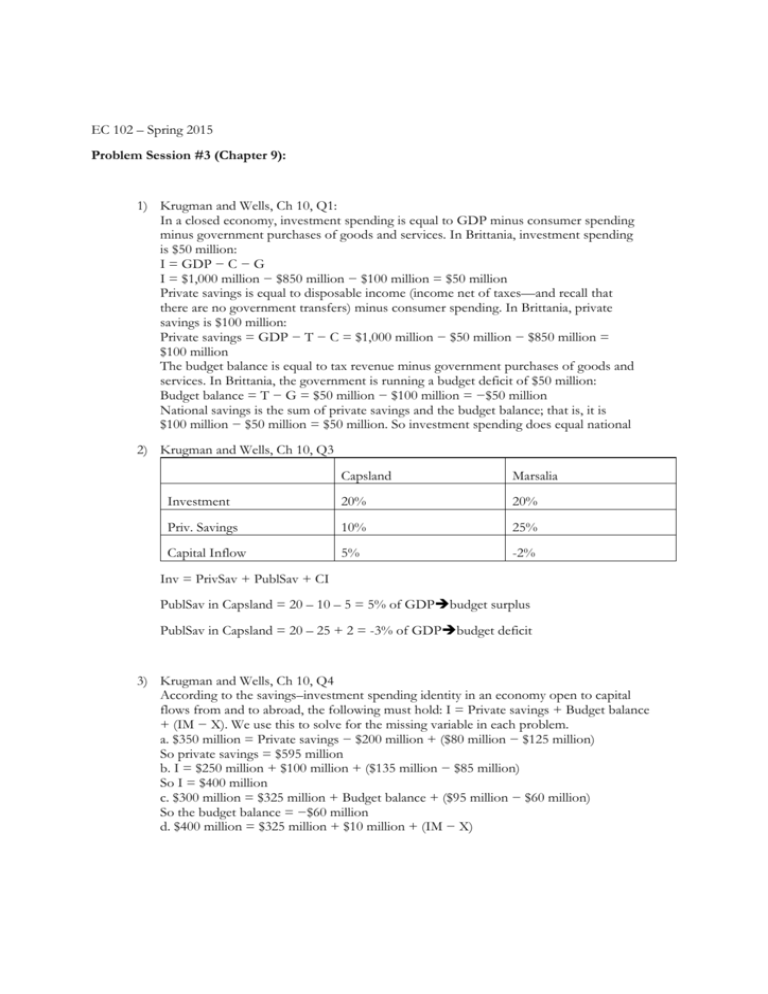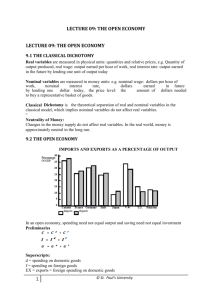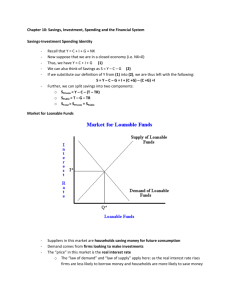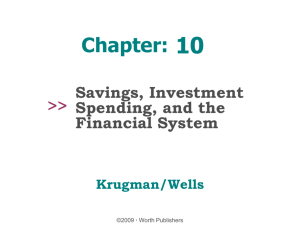Document
advertisement

EC 102 – Spring 2015 Problem Session #3 (Chapter 9): 1) Krugman and Wells, Ch 10, Q1: In a closed economy, investment spending is equal to GDP minus consumer spending minus government purchases of goods and services. In Brittania, investment spending is $50 million: I = GDP − C − G I = $1,000 million − $850 million − $100 million = $50 million Private savings is equal to disposable income (income net of taxes—and recall that there are no government transfers) minus consumer spending. In Brittania, private savings is $100 million: Private savings = GDP − T − C = $1,000 million − $50 million − $850 million = $100 million The budget balance is equal to tax revenue minus government purchases of goods and services. In Brittania, the government is running a budget deficit of $50 million: Budget balance = T − G = $50 million − $100 million = −$50 million National savings is the sum of private savings and the budget balance; that is, it is $100 million − $50 million = $50 million. So investment spending does equal national 2) Krugman and Wells, Ch 10, Q3 Capsland Marsalia Investment 20% 20% Priv. Savings 10% 25% Capital Inflow 5% -2% Inv = PrivSav + PublSav + CI PublSav in Capsland = 20 – 10 – 5 = 5% of GDPbudget surplus PublSav in Capsland = 20 – 25 + 2 = -3% of GDPbudget deficit 3) Krugman and Wells, Ch 10, Q4 According to the savings–investment spending identity in an economy open to capital flows from and to abroad, the following must hold: I = Private savings + Budget balance + (IM − X). We use this to solve for the missing variable in each problem. a. $350 million = Private savings − $200 million + ($80 million − $125 million) So private savings = $595 million b. I = $250 million + $100 million + ($135 million − $85 million) So I = $400 million c. $300 million = $325 million + Budget balance + ($95 million − $60 million) So the budget balance = −$60 million d. $400 million = $325 million + $10 million + (IM − X) 4) Krugman and Wells, Ch 10, Q6 a. If the government reduces its deficit to zero, there will be an increase in the supply of loanable funds, equal to the reduction in the size of the deficit. In response to the increase in supply, the interest rate will fall. This fall in interest rates will increase private investment spending and decrease private savings. b. If consumers decide to save more, there will be an increase in the supply of loanable funds. The increase in the supply of loanable funds reduces the equilibrium interest rate. In response to the lower interest rate, private investment spending will rise. c. Higher investment spending at any given interest rate leads to an increase in the demand for loanable funds. The increase in the demand for loanable funds shifts the demand curve and raises the equilibrium interest rate. In response to the higher interest rate, private savings will rise 5) Krugman and Wells, Ch 10, Q10 You might first acknowledge that, other things equal, when the government runs a budget deficit, there is a decrease in the supply of loanable funds. The decrease in supply raises interest rates and decreases private investment spending. This means that businesses will add less physical capital each year and productivity growth may be slower than it would be if the government had not borrowed to cover its deficit. However, you might then explain that some government purchases are necessary for economic growth. Government funds much of the infrastructure within which the economy operates (for example, the legal framework, the court system, and the communications network), and the government also invests in education, roads, and airports necessary for economic growth. 6) Krugman and Wells, Ch 10, Q17 a. Because bonds are a substitute asset for stocks, this will lead to a rise in all stock prices, including this company’s stock price. b. This will lead to an immediate rise in the company’s stock price because it is unexpected information that communicates to investors that the company’s sector is doing well, and so it is likely that the company will also experience higher sales and a higher-than-expected future profit. c. This will have no effect on the company’s stock price today because the effect of the change in the tax law on this year’s profit would have been incorporated into the company’s stock price when the tax law change was announced. d. This will have no effect on the company’s stock price today because the stock price is based on expectations about the future stock price, and this is unaffected by changes in previous years’ profits.











